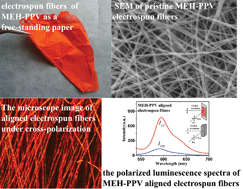A novel approach to electrospinning of pristine and aligned MEH-PPV using binary solvents
Abstract
Pristine and aligned electrospun fibers of poly[2-methoxy-5-(2′-ethylhexyloxy)-1,4-phenylenevinylene] (MEH-PPV) have been fabricated by

* Corresponding authors
a
Institute of Polymers, Nanchang University, 999 Xuefu Avenue, Nanchang, China
E-mail:
ywchen@ncu.edu.cn, lfan@ncu.edu.cn
Fax: +86 791 83969561
Tel: +86 791 83969562
b School of Material Science and Engineering, Nanchang Hangkong University, 696 Fenghe South Avenue, Nanchang, China
c Institute of Advanced Study, Nanchang University, 999 Xuefu Avenue, Nanchang, China
d
Department of Chemistry, Tsinghua University, 30 Shuangqing Road, Beijing, China
E-mail:
weiyen@tsinghua.edu.cn
Pristine and aligned electrospun fibers of poly[2-methoxy-5-(2′-ethylhexyloxy)-1,4-phenylenevinylene] (MEH-PPV) have been fabricated by

 Please wait while we load your content...
Something went wrong. Try again?
Please wait while we load your content...
Something went wrong. Try again?
W. Zhong, F. Li, L. Chen, Y. Chen and Y. Wei, J. Mater. Chem., 2012, 22, 5523 DOI: 10.1039/C2JM15970H
To request permission to reproduce material from this article, please go to the Copyright Clearance Center request page.
If you are an author contributing to an RSC publication, you do not need to request permission provided correct acknowledgement is given.
If you are the author of this article, you do not need to request permission to reproduce figures and diagrams provided correct acknowledgement is given. If you want to reproduce the whole article in a third-party publication (excluding your thesis/dissertation for which permission is not required) please go to the Copyright Clearance Center request page.
Read more about how to correctly acknowledge RSC content.
 Fetching data from CrossRef.
Fetching data from CrossRef.
This may take some time to load.
Loading related content
